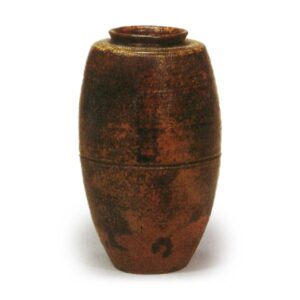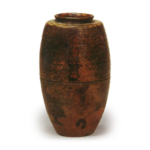
A great masterpiece. An old Seto tea caddy. Formerly known as Inazu Kashitatsu or Matsui Kashitatsu. When Hosokawa Sansai searched all over Bungo Province (Oita Prefecture), following the example of Izumo Kanamori who once hunted for tea caddies in his domain of Hida Province (Gifu Prefecture), Inazu Chubei, a retainer of Samori Matsui, offered Sansai a tea caddy he had once obtained in Echizen Province (Fukui Prefecture) for 70 ken. Ko-Oribe identified it as an old seto and marveled at it as the best in the world. It was discovered by Inazu, a retainer of Matsui, and was named Matsui Kashirazu or Inazu Kashirazu because of its location in the mountain. When Matsui Sadamori died, Inazu was martyred. Inazu was also known as “Jinsei” (meaning “life” in Japanese) because he bought this tea caddy for 70 yen, and also because his life was said to be 70 years old, a rarity in Japan. The name “Yama-no-i” comes from a poem by the monk Sawan, “Akasakutomo yoshiya, and there is no one to draw water from the mountain well. This tea caddy is of the Oseto type, majestic and grand in appearance. It is made of light persimmon with a black sesame glaze and no sagging. The yellow glaze is applied over the entire surface as if powdered from the shoulder, and there are many transparencies in the yellow on the shoulder and many band cracks on the body, and the mending is thick. The yellow glaze is applied over the entire surface as if it had been powdered from the shoulder, and the yellow shoulder is often transparent. After Sanzai, his adopted daughter moved to Hosokawa Tango-no-mori Yukitaka, feudal lord of Hizen-Udo, a branch domain of Hosokawa, and joined Matsudaira Fumai in 1778. (Matsuya Nikki (Matsuya Diary), Sanzai Monogatari (Tales of Sanzai), Gan-nin Meibutsu-ki (Records of Toys and Meibutsu), Ko-nin Meibutsu-ki (Records of Old and New Meibutsu), Meibutsu-ki (Records of Meibutsu), Kokin Meibutsu Ruiju (A Collection of Old and New Meibutsu), Seto Pottery Abundance Source, Taisho Meiki-kan (A Guide to Meikki))








